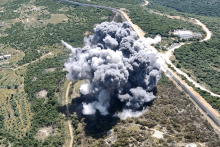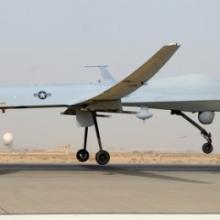drones

A group of us stood on a hill overlooking northern Gaza this spring, not far from the border fence. We were close enough to see the buildings of Beit Hanoun and Jabalia. After a few minutes of description by our guide, we surveyed the scene with binoculars. On closer inspection, what had appeared to be buildings turned out to be rows of rubble. While for months we have viewed such images on screens, actually seeing the destruction, through plumes of smoke and dust, was surreal.

Ten children, part of the same extended family, were killed by a U.S. air strike in Afghanistan, along with three adult civilians, the United Nations said on Monday. The air strike early on Saturday was part of a battle between the Taliban and combined Afghan and U.S. forces that lasted about 30 hours in Kunduz, a northern province where the Taliban insurgency is strong.

Which has ever brought a peaceful future nearer to neighborhoods: weaponized military and surveillance systems, or the efforts of concerned neighbors seeking justice? The United States withholds resources needed for the task of healing the battle scars our country has inflicted on so much of the world. If our fear is endless, how will these wars ever end?

Glancing upward at one of the six U.S.-manufactured aerostat blimps performing constant surveillance over Kabul, I wonder if the expensive, high-tech, giant’s-eye view encourages a primitive notion that the best way to solve a problem here is to target a “bad guy” and then kill him. If the bad guys appear to be scurrying dots on the ground below, stomp them out. But crushing only the right dots has proven very difficult for a U.S. drone warfare program documented to have killed many civilians.

STANLEY KUBRICK’S Dr. Strangelove or: How I Learned to Stop Worrying and Love the Bomb was released in 1964, and it was echoed later that year by a film on a similar topic, Fail-Safe. Directed by Sidney Lumet, Fail-Safe imagined the idea of a nuclear explosion being unpreventable by the people supposed to be in charge of it. Strangelove is hilarious but chilling satire; Fail-Safe is just chilling. The central notion, that ethics can’t be trusted to machines, lingers today: George Clooney produced a live television version of Fail-Safe as recently as 2000.
A current version of the dilemma is brilliantly portrayed in Eye in the Sky. Cutting between four main locations (a British government committee room, a military control center in the English countryside, a Nevada drone piloting bunker, and the Kenyan house from where a suicide bomb attack may be launched), it’s like a relentless tennis match in which the crisscrossing ball is a matter of life and death.
Who decides who can be killed? If blowing up the house will prevent an attack that might kill 80 people, how much does it matter that a little girl selling bread nearby will probably die too? What is legal? Does “legal” mean “right”? Such questions have rarely been handled with such compelling dexterity in a movie. Eye in the Sky deserves comparison with Dr. Strangelove and Fail-Safe because it doesn’t offer easy answers, only difficult questions, and its seamless movement between locations fully immerses the audience inside the debate. But it transcends those earlier films because of the way it treats the characters that might be seen as “other.”
1. Mourning Prince and David Bowie, Who Showed There’s No Right Way to Be a Man
“… We’ve lost two men who had an expansive, almost luxuriant vision of what it meant to be a man and lived out that vision through decades when it was much less safe to do so.”
2. On Earth Day, a Look at How Americans View Environmental Issues
Should the country do whatever it takes to protect the environment? The number of Republicans who say “yes” has decreased in the past 12 years.
3. Wage Gap Alarm Clock Rings After 79% of the Work Day Is Done So Women Can Go Home
Brilliant.

The joint statement — from the group who have experience of operating drones over Afghanistan, Iraq and other conflict zones — represents a public outcry from what is understood to be the largest collection of drone whistleblowers in the history of the program. Three of the letter writers were sensor operators who controlled the powerful visual equipment on U.S. Predator drones that guide Hellfire missiles to their targets.
…The four are represented legally by Jesselyn Radack, director of national security and human rights at the nonprofit ExposeFacts. “This is the first time we’ve had so many people speaking out together about the drone program,” she said, pointing out that the men were fully aware that they faced possible prosecution for speaking out.

Today (Oct. 26) marks the fourteenth anniversary of the passage of the Patriot Act, an initiative designed to strengthen the U.S. government’s ability to monitor and deter potential terrorist threats.
Though key provisions of the Patriot Act expired earlier this year, many of them were restored by the Senate via passage of the USA Freedom Act, and will be effective through 2019. At the same time, the Senate also voted overwhelmingly to end the NSA’s unmonitored mass surveillance and data collection of phone and email records, formerly justified under the language of the Patriot Act.

Everything must change.
Injustices around the world and here at home are coming to light despite a long, willful blindness. Half a world away, the long-muted voices of the victims of American military policy were allowed to break through the wall of propaganda and infotainment used to keep them hushed. A recent New York Times report reveals one of the worst-kept (actually un-kept, but vastly underreported) secrets of our government: that we often do not know who we are killing with drones.
And at home, in Baltimore, the death of Freddie Gray in police custody has caused long-simmering tensions – born of institutionalized segregation, nearly inescapable poverty, and a scourge of police brutality – to erupt in an uprising of passionate resistance, with destruction punctuating otherwise peaceful marches. Media coverage has given far more attention to the “riots” than to the systemic violence that has kept so many African Americans, not only in Baltimore but throughout the country, living in poverty and insecurity.
1. Drone Strikes Reveal Uncomfortable Truth: U.S. Is Often Unsure About Who Will Die
Following the president’s admission this week that two Western hostages were killed in a drone strike in Pakistan, protestations against the veiled drone program have re-escalated. “Every independent investigation of the strikes has found far more civilian casualties than administration officials admit. Gradually, it has become clear that when operators in Nevada fire missiles into remote tribal territories on the other side of the world, they often do not know who they are killing, but are making an imperfect best guess.
2. Infertility and the Role of the Church
This week is Infertility Awareness Week. Writer Rachel Marie Stone dives into some of the attitudes about infertility and reproductive technologies in the church.
3. Meet Your New Attorney General
After postponing a vote for more than five months to fight along party lines over abortion language in a human trafficking bill, the Senate voted Thursday to approve the nomination of Loretta Lynch, 55, making her the first black woman to head up the Justice Department.
4. Those Countries at the Top of the World Happiness Report Also Have Great Press Freedom Rankings
See what country falls where and read more about the correlation.

Bugsplat is software used to calculate and reduce the death of innocent people in drone strikes. It's also how Predator drone operators talk about the people whom the American military kills in these missions. The Bureau of Investigative Journalism estimates that the U.S. is responsible for 2,500 deaths in Pakistan, Yemen, Somalia since 2001, including dozens of children. This figure doesn¹t even count Iraq and Afghanistan. But we don't know for sure how many innocents die because most Americans, including too many of our political and military leaders, do not even know when drone strikes happen, whom exactly they target and why, and whether they are successful in achieving their objectives.
Drone attacks require the president's review and approval. And it is the military's responsibility to execute plans so that no innocent lives are lost. But our democracy is a work in progress, and it will only function well if American citizens stay involved. Given President Obama's request last fall for Congress to approve strikes in Syria, we should call on elected officials to fully debate the 2001 Authorization for Use of Military Force — which has often served as a blanket legal justification for drone strikes, going far beyond its original purpose to take action against those responsible for the September 11 attacks. Repealing the act will help reinstate the checks and balances that are hallmarks of democracy. Our leaders must be more transparent.

After a week here in FMC Lexington Satellite camp, a federal prison in Kentucky, I started catching up on national and international news via back issues of USA Today available in the prison library. An "In Brief" item, on p. 2A of the Jan. 30 weekend edition, caught my eye. It briefly described a protest in Washington, D.C., in which members of the antiwar group "Code Pink" interrupted a U.S. Senate Armed Services budget hearing chaired by Sen. John McCain (R-Ariz.). The protesters approached a witness table where Henry Kissinger, Madeleine Albright, and George Schulz were seated. One of their signs called Henry Kissinger a war criminal. "McCain," the article continued, "blurted out, 'Get out of here, you low-life scum.'"
At mail call, a week ago, I received Richard Clarke's novel, The Sting of the Drone, about characters involved in developing and launching drone attacks. I'm in prison for protesting drone warfare, so a kind friend ordered it for me. The author, a former "National Coordinator for Security and Counterterrorism," worked for 30 years inside the U.S. government but seems to have greater respect than some within government for concerned people outside of it. He seems also to feel some respect for people outside our borders.
He develops, I think, a fair-minded approach toward evaluating drone warfare given his acceptance that wars and assassinations are sometimes necessary. (I don't share that premise). Several characters in the novel, including members of a House Permanent Select Committee on Intelligence, criticize drone warfare, noting that in spite of high level, expensive reconnaissance, drone attacks still kill civilians, alienating people the U.S. ostensibly wants to turn away from terrorism.

For the Obama administration and the Bush administration before it, drone strikes kill terrorists before terrorists can kill innocents, and the strikes keep American soldiers out of harm’s way.
But for a group of faith leaders, drones are a crude tool of death that make killing as easy as shooting a video game villain, and they put innocents in harm’s way.
These religious critics — 150 ministers, priests, imams, rabbis, and other faith leaders who gathered at the Interfaith Conference on Drone Warfare at Princeton Theological Seminary in late January — have spent the weeks since drafting a statement that calls on the U.S. to halt targeted lethal drone strikes.
“There are enough problems with the current drone policy and the use of drones that we need a break,” said the Rev. Richard Killmer, director of the conference. “Drones have become a weapon of first resort and not last resort. It has made it a lot easier to go to war.”

The Bureau of Prisons contacted me today, assigning me a prison number and a new address: for the next 90 days, beginning tomorrow, I’ll live at FMC Lexington, in the satellite prison camp for women, adjacent to Lexington’s federal medical center for men. Very early tomorrow morning, Buddy Bell, Cassandra Dixon, and Paco and Silver, two house guests whom we first met in protests on South Korea’s Jeju Island, will travel with me to Kentucky and deliver me to the satellite women’s prison outside the Federal Medical Center for men.
In December 2014, Judge Matt Whitworth sentenced me to three months in federal prison after Georgia Walker and I had attempted to deliver a loaf of bread and a letter to the commander of Whiteman Air Force base, asking him to stop his troops from piloting lethal drone flights over Afghanistan from within the base. Judge Whitworth allowed me more than a month to surrender myself to prison; but whether you are a soldier or a civilian, a target or an unlucky bystander, you can’t surrender to a drone.
When I was imprisoned at Lexington prison in 1988, after a federal magistrate in Missouri sentenced me to one year for planting corn on nuclear missile silo sites, other women prisoners playfully nicknamed me “Missiles.” One of my sisters reliably made me laugh today, texting me to ask if I thought the women this time would call me “Drones.”
It’s good to laugh and feel camaraderie before heading into prison. For someone like me, very nearly saturated in “white privilege” through much of this arrest, trial, and sentencing process, 90 percent (or more) of my experience will likely depend on attitude.

Since June 18, 2004, the first day U.S. drones killed people in what has been called the U.S. “global war on terror,” people of faith have questioned whether the use of lethal drones is justifiable.
Since then, the CIA has conducted an estimated 400 or more drone strikes in Pakistan, Yemen and Somalia. Drone strikes are continuing in Syria and Iraq. Hundreds of civilians have been killed, according to the Bureau of Investigative Journalism, including women and children.
These “targeted” killings are conducted remotely in countries against which we have not declared war. Lethal drone strikes occur without warning, target for death specific individuals who are secretly selected, and are operated remotely by individuals thousands of miles away.
The U.S. religious community questions the morality of such drone warfare.
Many people of faith who are not pacifists adhere to the “Just War” tradition as enshrined in international law, which assumes that war is always an evil, but that sometimes there is a greater evil that requires military force.

On Oct. 7, Georgia Walker and I appeared before Judge Matt Whitworth in a Jefferson City, Mo., federal court on a charge of criminal trespass to a military facility. The charge was based on our participation in a June 1 rally at Whiteman Airforce Base protesting drone warfare. Walker and I attempted to deliver a loaf of bread and a letter to the base commander, encouraging the commander to stop cooperating with any further usage of unmanned aerial vehicles, (drones) for surveillance and attacks.
The prosecutor, USAF Captain Daniel Saunders, said that if we would plead guilty to the charge, he would seek a punishment of one month in prison and a $500 fine. We told the prosecutor we could accept a “no contest” plea but were not willing to plead guilty. The prosecutor then said he would recommend a three-month prison sentence and a $500 fine. The judge refused to accept a “no contest” plea. We then requested a trial, which has been set for Dec. 10.

Editor’s Note: ‘Left Behind’ starring Nicolas Cage hits theaters nationwide on Friday, Oct. 3. The film is based on the wildly popular book series and movies of the same title, in which God raptures believers and leaves unbelievers behind to learn follow Jesus and defeat the Antichrist. So how’s the film reboot?
Sojourners Web editors called up a group of religion writers in D.C. to watch and review the movie together. We left with more questions than answers. Here’s our takeaway on all things ‘Left Behind’ — and a little Nic Cage.
Catherine Woodiwiss, Associate Web Editor, Sojourners: So first things first — why Left Behind again?
When the books were published [starting in 1995], there was a debate happening in Christianity over whether Hell was a real, physical place. And the original movies were produced in the context of 9/11 and the Iraq war. So you can look and say, okay, this was a time of questioning what some saw as fundamental beliefs, of war and terrorism. So the popularity of an end-times series makes some sense.
But why now? Why today?

Here at Sojourners we have written a lot about nonviolence. We take seriously the words of Jesus that we should love our enemies and pray for those who persecute us. We believe that violence begets violence, or as Jesus put it, “Those who live by the sword die by the sword.” Personally, I take seriously the words of René Girard, the founder of mimetic theory, that we are now “confronted with a perfectly straightforward and even scientifically calculable choice between total destruction and the total renunciation of violence.”
Many Christians look to the Bible to justify divinely sanctioned violence against our enemies. Excuse me for stating the obvious, but Christians are not Biblians. We are Christians. As Christians, we should be putting Jesus first. Not Deuteronomy. Not Joshua. Not Judges. Not David. Not Solomon. Not Peter. Not Paul. Not the Bible.
Jesus first.
And Jesus calls us to nonviolence. As one of the early Christians stated, the way of Jesus, the way of nonviolent love that embraces our enemies, is the way of the cross and the world thinks that way is foolish.
We proclaim Christ crucified, a stumbling block to the Jews and foolishness to the Gentiles, but to those who are the called, both Jews and Greeks, Christ the power of God and the wisdom of God. For God’s foolishness is wiser than human wisdom, and God’s weakness is stronger than human strength.

“The final perversion is the reversal of who is the real victim here: the commander of a military base whose drones kill innocent people halfway around the world, or those innocent people themselves who are the real ones in need of protection from the terror of U.S. drone attacks?”

I have followed, with great interest, as my friend, Ian Ebright, ran a successful Kickstarter campaign for, and then completed, his short film on American drones called “From the Sky.” It’s a sensitive and nuanced treatment of those on the receiving en of our hi-tech military aggression.
This, combined with all I’ve read at Sojourners and in Time magazine, among other places about these low-risk (to us), high-efficiency (for us) killing machines, helped solidify in my mind a fairly resolute sentiment: Drones are bad.
And then I read, with great interest, my most recent issue of Popular Science, which details the physics and engineering behind these new insect-size drone bots, which replicated insect flight for the first time in the machine world. These highly nimble and portable gadgets are already being used for everything from reconnaissance and recovery on disaster sites to pollinating crops in areas where the indigenous bee population has been decimated.
So, of course, these exciting new breakthroughs left me with only one resolute sentiment: Drones are awesome!